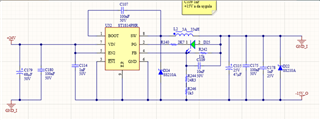Other Parts Discussed in Thread: LMR16030
Tool/software:
I have designed buck converter to convert polarity +24V to -15V but ı have a question
I want to change vout to input gnd , can work stable you think?

This thread has been locked.
If you have a related question, please click the "Ask a related question" button in the top right corner. The newly created question will be automatically linked to this question.
Hi,
Sorry, I did not understand the question. Can you clarify what you meant by "change vout to input gnd"?
VOUT is -5V with respect to input ground.
Regards,
Niranjan
actually ı want to make to -15V from +24V If ı connected Vout to Input GND , Do it work properly?
ı designed that like image.

Hi,
Is this the actual schematic? The device shown here is not LM22670.
Regards,
Niranjan
I will make like this with lm22670 , but ı am not sure about whether it will work properly.
Yes, this will work. In the first image you posted, both grounds are meant to be the same. However, one thing to note is that the voltage appearing across the device will be 24+15=39V and the absolute max. voltage of the device is 43V which is close. So you will have to ensure that there are no large transients at VIN.
Another option is to use a higher voltage device, for eg. LMR16030 : https://www.ti.com/lit/ds/symlink/lmr16030.pdf
Also, what is the load current in your application?
Regards,
Niranjan
Normally this IC 3A Why can not use this current rate in reverse polarity situation , ı guess have to decrease current rate , by the way ı realized that when ı use in the output 47uF capacitor , IC sometimes dont start sometimes start sometimes late start so not work stable , ı cant understand situaiton also if ı dont use output capacitor its work perfect.
also thank you very much I will change the IC you suggest.
In inverting configuration the current through the inductor will be larger than the output current, = IOUT(1+|VOUT|/VIN). So in this case, a 3A IC can support a maximum of 3/(1+15/24) = approx. 1.8A. In practice it will be a bit lower since this equation is assuming 100% efficiency.
Can you share the schematic of the circuit where you observed the issue of IC not starting? The schematic you shared cannot be adapted exactly for a different IC and the components will have to be changed accordingly.
everything okey thank you very much for your information ı will change your suggest IC , one thing ı dont understand is why dont work stable in large output capacitance at the ı shared schematic. it dont take reference probably or I don't know if it's drawing high current at startup or if the capacitor can't charge.
Whatever :)
One reason for the IC not starting up could be that it goes into overcurrent protection at startup. When you try to startup with a high load, this combined with the current to charge the output capacitor can go over the IC overcurrent limit. A large output capacitor will need more current to charge, so this would make it more prone to going into that protection and not starting up. Can you try using a smaller capacitor and see if the issue goes away?
Just to make sure I understand the issue correctly, are you using the attached schematic but with IC changed to lm22670?

I understand all , thank you yes you are right understand , ı am not using lm22670 yet , but as ı said i will change because ı dont have lm22670 even LMR16030.
thank you very much for your information.
Glad to be of help. I believe the LMR16030 would be better suited to your application given the input range. One more thing, it is recommended to connect an additional capacitance between VIN and the -15V VOUT. Currently I see that there is a 1nF cap in this schematic. This is too low. For LMR16030, I would suggest connecting a 4.7uF to 10uF ceramic capacitor and another 0.1uF capacitor in parallel with it to filter out high frequency noise.
Feel free to reach out if you have any additional questions. If not, you can close the thread by clicking the resolved button.